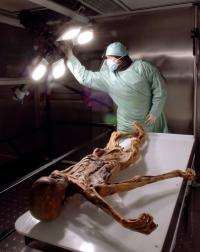Crucial mummy found 20 years ago Monday

Twenty years ago Monday, a German couple hiking the Italian Alps veered off a marked footpath and stumbled upon one of the world's oldest and most important archeological finds: Oetzi, "The Iceman".
Oetzi fast became a sensation, not just because he proved to be more than 5,000 years old, but because his remains were so well-preserved, allowing paleontologists to uncover new details about the Stone Age in Europe.
On September 19, 1991, Helmut and Erika Simon from Nuremburg were hiking at an altitude of 3,210 meters (10,500 feet) in the Italy's South Tyrol alps, according to an account published online by the South Tyrol Museum of Archeology.
Toward the end of a hot summer, much of the ice and snow had melted. Protruding out of a icy patch, face down on exposed rock and embedded in a gully, they noticed what looked like the top half of a human corpse.
The Simons assumed they had discovered the remains of a hiker, perhaps killed by avalanche a few years earlier. They took a picture, and headed off to report their find, according to the museum's website.
But Oetzi turned out to be what paleontologists call a "wet mummy", a rare and precious discovery, where the corpse's individual cells have retained enough humidity to allow scientists to conduct detailed investigations on the remains.
Until the Simons spotted Oetzi "such a well preserved find of a human several thousand years old - fully clothed and with numerous personal belongings - had never before been seen anywhere in the world," the South Tyrol museum says online.
"The Ice Man" was also a natural mummy, meaning his flesh was not altered by the burial rites practiced in some societies, like ancient Egypt, which further expanded the corpse's reseach potential.

Once the body was extracted and examined, experts established that Oetzi was 1.6 meters tall (five feet, two inches), weighed 50 kilograms (110 pounds), and, most importantly, that he had died more than 5,000 years earlier.
Oetzi has been studied extensively over the past two decades, and coinciding with the 20th anniversary of his discovery, the South Tyrol museum has organised an exhibit highlighting some of the crucial revelations.
"The Iceman has provided new data from prehistoric times (...) both in the natural sciences and in the humanities," the museum's online exhibit says.
"Using the Iceman as a starting point, it has been possible to conduct research into how specific organic artefacts and present-day diseases originated, to develop new diagnostic techniques and to gain information on climatic developments."
Research has also focused on the Oetzi's personal history, including a notable 2001 study that concluded he likely bled to death from an arrow wound to the shoulder that severed a major blood vessel.
His copper axe, found remarkably well-preserved near the remains, indicated that he was part of the warrior, or leadership, class. Some have suggested that he was a shaman who retired to the Alps for spiritual meditation.
While Oetzi's discovery was celebrated by the international scientific community, it also provoked a mild political controversy.
There was initial confusion about whether "The Ice Man" was found in Austria or Italy, because the border, defined by a post-First World War treaty between Austria and the Allied Powers, was difficult to identify in the glacial alps.
But an October 1991 survey put "The Ice Man" in Italy, 93 metres from the Austrian border.
He remains in Italy today, on display at the museum in South Tyrol.
(c) 2011 AFP


















